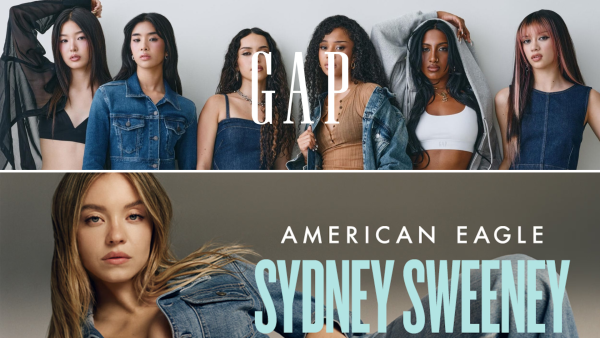
From flashy advertisements to bold social media statements, brands like American Eagle Outfitters (AEO) and GAP aren’t just selling clothes; they’re selling messages. As more companies take public stances on social and political issues, young consumers are paying attention and asking deeper questions: Is this campaign authentic, or just a marketing tactic? Should a CEO’s opinions affect where I shop? With every scroll and purchase, Gen Z is navigating a new kind of consumer culture – one where values, controversy, and brand identity collide.
How ads like Sydney Sweeney’s for AEO and KATSEYE for GAP influence students
Out of the striking contrast between two high-profile fashion commercials: AEO and actress Sydney Sweeney’s co-branding, and GAP’s trending jeans commercial with the girl group KATSEYE. The two commercials were targeted at Gen Z but produced different reactions. The AEO commercial turned into news, and was unpopular, due to controversy over beauty standards, ethnicity, and social media outrage, while the GAP commercial went viral due to its catchy melody and simple dance choreography that teenagers could easily be part of and copy. James Campbell High School, Business teacher Rina Pasamonte noted that even if her students only heard the GAP commercial music in class, many of them were already familiar with it due to social media.
“Some of my students were so easily influenced if an ad resonated with their interests,” she said.
“They started noticing advertisements all over, from malls to Facebook to even our School Homecoming fair.” DECA (Distributive Education Clubs of America – a student organization specializing in marketing, finance, management, and entrepreneurship) student, Danica Viloria, said further that “GAP received a lot of love” for its trendy strategy, while American Eagle’s controversy still generated publicity and sales.
GAP’s strategy appears to have worked; the brand outsold AEO on quarterly sales growth, being 2.2% vs. -4.7% and had a healthier last 12 months margin, 7.7% vs. 5.7%. These figures suggest that controversy will get people in an uproar, but positive and relatable branding wins out with students.
Do company policies and controversies matter to students?
Though social concerns and corporate values are more publicly apparent than ever before, students across the country seem to be more interested in style, cost, and fame than in a company’s political or moral positions.
Viloria said, “Controversies surrounding an ad or policy by a brand do not typically affect how students shop… good quality for a low price beats out company values.”
She emphasized that affordability and what’s current in today’s economy dictate choices, fast fashion wins, even if it’s from brands with questionable values. However, not all students are completely indifferent.
Joshua Tom, a co-president of James Campbell High School DECA, argued that branding still determines perception:
“Although it does not necessarily affect immediate consumption, commercials become part of the conversation when they leave a lasting impression.” He further added that controversy can damage a brand, but only temporarily. “With attention spans shortening as they are in our generation… I don’t believe controversies are a guaranteed death penalty for companies.”
Despite the fact that Pasamonte believes it is significant that students are taught to critically analyze advertising and brand communications, she does acknowledge that companies typically create ads that emotionally engage teenagers, through trends, influencers, and aesthetics, more than through values that are substantive.
Brand Values VS Aesthetics: What do students actually care about?
Though social consciousness towards issues has grown, Campbell High students care more about brand image and appearance than about ethics.
“Fashion that’s cool, convenient, and affordable for unemployed teens dominates fashion that has significance and is too pricey,” Valoria said.
Stüssy and Sprayground are popular brands not as much for value or principle, but due to what they represent. Tom said that “students are more affected by brand image and consistency versus quality and price.” Some students notice when companies stand up, but there aren’t too many of them who change their behavior in the end.
Pasamonte wishes to get students to ask more in-depth questions of the media, “Who is responsible for this message, and why?”, but even she sees how quickly fads conquer critical thinking. In a surprising turn of events, GAP’s hip and playful ad may have earned more loyalty than American Eagle’s more divisive strategy. GAP not only beat AEO in recent historical revenue growth but also logged an astounding 118.1% turnaround over the last three years against AEO’s 5.4%. In the end, most teenagers still appreciate price and looks, meaning that although brands can be bold, they’re still best if they acknowledge the teenager’s desire to stay current without breaking the bank.
In the end, while students at James Campbell High School may notice a brand’s values or controversies, most still care more about price, style, and what’s trending. Ads like GAP’s KATSEYE campaign grab attention through fun and creativity, while American Eagle’s more controversial Sydney Sweeney ad sparked conversation but didn’t stop students from shopping. Even though some James Campbell High School students are becoming more aware of marketing strategies and brand messages, fast fashion and affordability still tend to win. As future consumers, creators, and even business leaders, Campbell students are beginning to see how branding shapes what they buy and believe. The real question is: how much do their purchases reflect who they are, and how much are brands deciding that for them?

